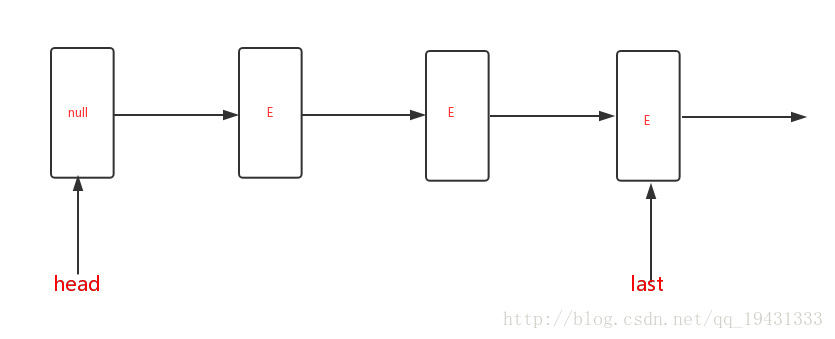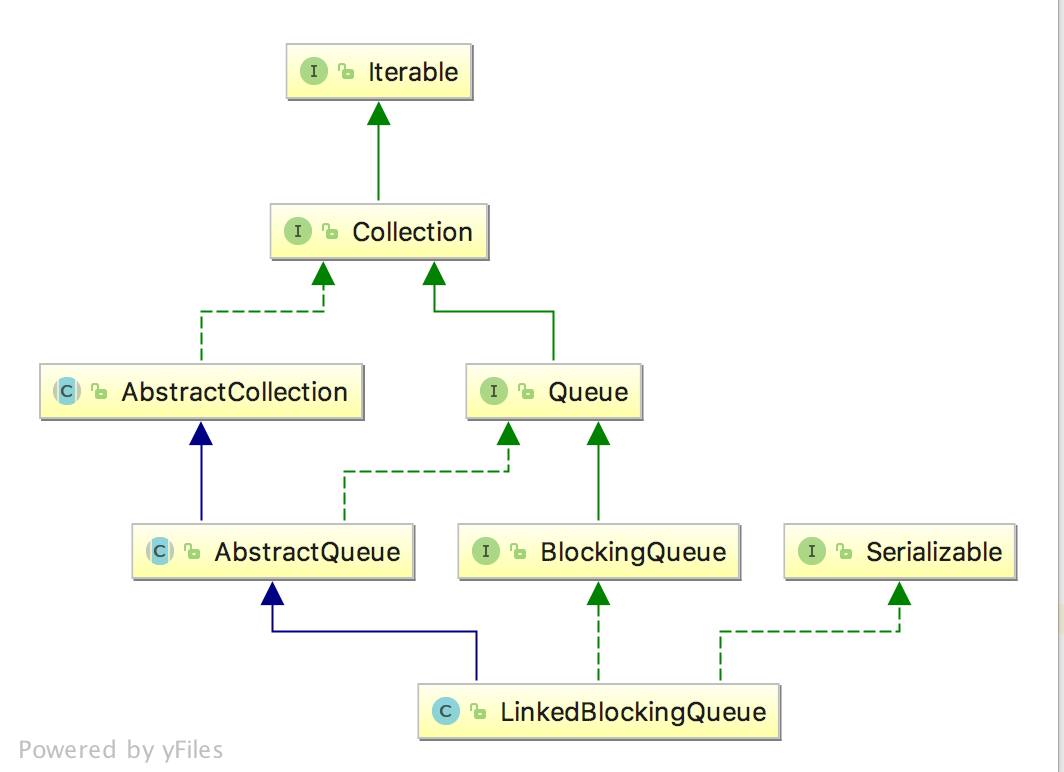开篇
LinkedBlockingQueue是一个基于链表实现的可选容量的线程安全的阻塞队列。队头的元素是插入时间最早的,队尾的元素是最新插入的。新的元素将会被插入到队列的尾部。
LinkedBlockingQueue的容量限制是可选的,如果在初始化时没有指定容量,那么默认使用int的最大值作为队列容量。
LinkedBlockingQueue的逻辑存储效果如下图:
LinkedBlockingQueue类图
LinkedBlockingQueue类定义及构造函数
LinkedBlockingQueue的类定义当中有几个知识点需要注意一下:
- LinkedBlockingQueue是有容量限制的,未传参默认Integer.MAX_VALUE
- LinkedBlockingQueue当中保存的Node节点包含指向下一个节点的next指针
- LinkedBlockingQueue包含head指针和last指针,分别指向头部和尾部元素
- LinkedBlockingQueue不支持null元素,head元素不保存任何元素的,last保存最后一个元素
public class LinkedBlockingQueue<E> extends AbstractQueue<E>
implements BlockingQueue<E>, java.io.Serializable {
private static final long serialVersionUID = -6903933977591709194L;
//存储节点的元素
static class Node<E> {
E item;
Node<E> next;
Node(E x) { item = x; }
}
//容量和当前节点的个数
private final int capacity;
private final AtomicInteger count = new AtomicInteger();
//头部指针和尾部指针
transient Node<E> head;
private transient Node<E> last;
// take操作的锁和对应的Condition
private final ReentrantLock takeLock = new ReentrantLock();
private final Condition notEmpty = takeLock.newCondition();
// put操作的锁和对应的Condition
private final ReentrantLock putLock = new ReentrantLock();
private final Condition notFull = putLock.newCondition();
public LinkedBlockingQueue() {
this(Integer.MAX_VALUE);
}
public LinkedBlockingQueue(int capacity) {
if (capacity <= 0) throw new IllegalArgumentException();
this.capacity = capacity;
last = head = new Node<E>(null);
}
// LinkedBlockingQueue不支持null元素
public LinkedBlockingQueue(Collection<? extends E> c) {
this(Integer.MAX_VALUE);
final ReentrantLock putLock = this.putLock;
putLock.lock(); // Never contended, but necessary for visibility
try {
int n = 0;
for (E e : c) {
if (e == null)
throw new NullPointerException();
if (n == capacity)
throw new IllegalStateException("Queue full");
enqueue(new Node<E>(e));
++n;
}
count.set(n);
} finally {
putLock.unlock();
}
}
}
LinkedBlockingQueue的take相关操作
take相关的操作逻辑按照下面的顺序执行:
- 获取锁并判断是否存在元素,如果元素个数为0则等待,否则往下执行
- 从queue中通过移动head指针获取元素并原子性的执行操作:获取当前元素个数并对元素执行减操作
- 如果减一前元素个数多于1个,那么说明还有剩余可消费元素,那么通过notEmpty.signal()通知消费
- 仔细想想上面的逻辑,因为put操作只会在从无到有的时候才会唤醒消费线程,而假设现在有10个消费线程等待消费元素,而10个put只有第一个put执行了唤醒,也就是说10-1=9个消费线程依旧没有唤醒,所以才通过执行take的时候连带唤醒消费线程,我自己个人的理解,网上米有类似资料
public E take() throws InterruptedException {
E x;
int c = -1;
final AtomicInteger count = this.count;
final ReentrantLock takeLock = this.takeLock;
takeLock.lockInterruptibly();
try {
while (count.get() == 0) {
notEmpty.await();
}
x = dequeue();
c = count.getAndDecrement();
if (c > 1)
notEmpty.signal();
} finally {
takeLock.unlock();
}
if (c == capacity)
signalNotFull();
return x;
}
public E poll(long timeout, TimeUnit unit) throws InterruptedException {
E x = null;
int c = -1;
long nanos = unit.toNanos(timeout);
final AtomicInteger count = this.count;
final ReentrantLock takeLock = this.takeLock;
takeLock.lockInterruptibly();
try {
while (count.get() == 0) {
if (nanos <= 0)
return null;
nanos = notEmpty.awaitNanos(nanos);
}
x = dequeue();
c = count.getAndDecrement();
if (c > 1)
notEmpty.signal();
} finally {
takeLock.unlock();
}
if (c == capacity)
signalNotFull();
return x;
}
public E poll() {
final AtomicInteger count = this.count;
if (count.get() == 0)
return null;
E x = null;
int c = -1;
final ReentrantLock takeLock = this.takeLock;
takeLock.lock();
try {
if (count.get() > 0) {
x = dequeue();
c = count.getAndDecrement();
if (c > 1)
notEmpty.signal();
}
} finally {
takeLock.unlock();
}
if (c == capacity)
signalNotFull();
return x;
}
public E peek() {
if (count.get() == 0)
return null;
final ReentrantLock takeLock = this.takeLock;
takeLock.lock();
try {
Node<E> first = head.next;
if (first == null)
return null;
else
return first.item;
} finally {
takeLock.unlock();
}
}
private E dequeue() {
Node<E> h = head;
Node<E> first = h.next;
h.next = h; // help GC
head = first;
E x = first.item;
first.item = null;
return x;
}
private void signalNotFull() {
final ReentrantLock putLock = this.putLock;
putLock.lock();
try {
notFull.signal();
} finally {
putLock.unlock();
}
}
LinkedBlockingQueue的put相关操作
put相关的操作逻辑按照下面的顺序执行:
- 获取锁并判断Queue是否已满,如果已满就等待notFull.await()
- 如果未满那么就通过移动tail指针添加元素,获取原来元素个数后对元素个数加操作,如果元素个数加操作后仍然未达到容量上限,那么连带唤醒put线程,原因也是take线程只会在从满到不满的那一刹那才会通知,同样假设10个put线程和10个消费线程,10个消费线程阻塞在put操作当中,此时有10个线程开始消费,但是仅仅第一个消费线程会进行signalNotFull通知,其他的9个put线程只有靠put连带才能继续执行。
- enqueue的操作很简单,直接操作last指针即可
public void put(E e) throws InterruptedException {
if (e == null) throw new NullPointerException();
int c = -1;
Node<E> node = new Node<E>(e);
final ReentrantLock putLock = this.putLock;
final AtomicInteger count = this.count;
putLock.lockInterruptibly();
try {
while (count.get() == capacity) {
notFull.await();
}
enqueue(node);
c = count.getAndIncrement();
if (c + 1 < capacity)
notFull.signal();
} finally {
putLock.unlock();
}
if (c == 0)
signalNotEmpty();
}
public boolean offer(E e, long timeout, TimeUnit unit)
throws InterruptedException {
if (e == null) throw new NullPointerException();
long nanos = unit.toNanos(timeout);
int c = -1;
final ReentrantLock putLock = this.putLock;
final AtomicInteger count = this.count;
putLock.lockInterruptibly();
try {
while (count.get() == capacity) {
if (nanos <= 0)
return false;
nanos = notFull.awaitNanos(nanos);
}
enqueue(new Node<E>(e));
c = count.getAndIncrement();
if (c + 1 < capacity)
notFull.signal();
} finally {
putLock.unlock();
}
if (c == 0)
signalNotEmpty();
return true;
}
public boolean offer(E e) {
if (e == null) throw new NullPointerException();
final AtomicInteger count = this.count;
if (count.get() == capacity)
return false;
int c = -1;
Node<E> node = new Node<E>(e);
final ReentrantLock putLock = this.putLock;
putLock.lock();
try {
if (count.get() < capacity) {
enqueue(node);
c = count.getAndIncrement();
if (c + 1 < capacity)
notFull.signal();
}
} finally {
putLock.unlock();
}
if (c == 0)
signalNotEmpty();
return c >= 0;
}
private void enqueue(Node<E> node) {
// assert putLock.isHeldByCurrentThread();
// assert last.next == null;
last = last.next = node;
}
private void signalNotEmpty() {
final ReentrantLock takeLock = this.takeLock;
takeLock.lock();
try {
notEmpty.signal();
} finally {
takeLock.unlock();
}
}
迭代器
迭代器这边跟ArrayBlockingQueue差不多,就不多说了,估计看也看的懂,无非就是初始化、移动指针,返回当前元素的值。
public Iterator<E> iterator() {
return new Itr();
}
private class Itr implements Iterator<E> {
private Node<E> current;
private Node<E> lastRet;
private E currentElement;
Itr() {
fullyLock();
try {
current = head.next;
if (current != null)
currentElement = current.item;
} finally {
fullyUnlock();
}
}
public boolean hasNext() {
return current != null;
}
private Node<E> nextNode(Node<E> p) {
for (;;) {
Node<E> s = p.next;
if (s == p)
return head.next;
if (s == null || s.item != null)
return s;
p = s;
}
}
public E next() {
fullyLock();
try {
if (current == null)
throw new NoSuchElementException();
E x = currentElement;
lastRet = current;
current = nextNode(current);
currentElement = (current == null) ? null : current.item;
return x;
} finally {
fullyUnlock();
}
}
}






